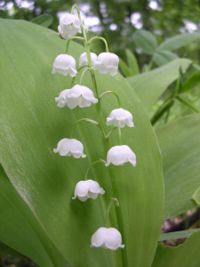Lily of the Valley: Difference between revisions
New page: {{Plantbox | name = ''Convallaria majalis'' | common_names = Lily of the Valley | growth_habit = herbaceous rhizome | high = 6-12in | wide = 9-12in | origin = Europe | poisonous = all part... |
No edit summary |
||
| Line 27: | Line 27: | ||
| species = majalis | | species = majalis | ||
}} | }} | ||
Graceful groundcover growing 6in or a little more high, with creeping rhizomes. Arching stems bloom for 2 or 3 weeks in the spring, with nodding, nicely scented flowers shaped like little white bells. The attractive broad green leaves are deciduous, and the plants produce red berries in the autumn. They and the rest of the plant are poisonous. Some cultivars have variegated (with cream) foliage, double blooms, or pink blooms. Good ground cover for places with light to medium shade, but where well adapted can become invasive as it | Graceful [[groundcover]] growing 6in or a little more high, with creeping [[rhizomes]]. Arching stems bloom for 2 or 3 weeks in the spring, with nodding, nicely scented [[flowers]] shaped like little white bells. The attractive broad green [[leaves]] are [[deciduous]], and the plants produce red berries in the [[autumn]]. They and the rest of the plant are poisonous. Some cultivars have [[variegated]] (with cream) foliage, double blooms, or pink blooms. Good ground cover for places with light to medium [[shade]], but where well adapted can become [[invasive]] as it [[naturalize]]s. | ||
==Cultivation== | ==Cultivation== | ||
| Line 47: | Line 47: | ||
| notes = | | notes = | ||
}} | }} | ||
Soil should be damp, rich and leafy. Apply thick leaf mold | Soil should be damp, rich and leafy. Apply thick leaf mold [[mulch]] in the fall for great [[spring]] flowers and health. [[Pip]]s (single rhizomes) and plants should be planted in the yard before soil freezes. Place plants 1-2 feet apart, and pips 4-5in apart. | ||
===Propagation=== | ===Propagation=== | ||
Remove flesh from ripe seeds and sow in cold frame. Rhizomes can be divided in the fall. A 6 inch rhizome can be divided into about 6 new plants. Keep young plants moist, preferably with mulch. | Remove flesh from ripe [[seeds]] and [[sow]] in [[cold frame]]. Rhizomes can be divided in the fall. A 6 inch rhizome can be divided into about 6 new plants. Keep young plants moist, preferably with mulch. | ||
===Pests and diseases=== | ===Pests and diseases=== | ||
Botrytis can be a small problem, though not usually something to be concerned with. | [[Botrytis]] can be a small problem, though not usually something to be concerned with. | ||
==Species== | ==Species== | ||
Revision as of 03:04, 1 February 2009
Convallaria majalis {{{latin_name}}}
|
Lily of the Valley
| ||||||||||||||||||||||||||||||||||||||||
|---|---|---|---|---|---|---|---|---|---|---|---|---|---|---|---|---|---|---|---|---|---|---|---|---|---|---|---|---|---|---|---|---|---|---|---|---|---|---|---|---|---|

|
|
| |||||||||||||||||||||||||||||||||||||||
| |||||||||||||||||||||||||||||||||||||||||
Graceful groundcover growing 6in or a little more high, with creeping rhizomes. Arching stems bloom for 2 or 3 weeks in the spring, with nodding, nicely scented flowers shaped like little white bells. The attractive broad green leaves are deciduous, and the plants produce red berries in the autumn. They and the rest of the plant are poisonous. Some cultivars have variegated (with cream) foliage, double blooms, or pink blooms. Good ground cover for places with light to medium shade, but where well adapted can become invasive as it naturalizes.
Cultivation
| Lily of the valley calendar? | ||
|---|---|---|
| January: | ||
| February: | ||
| March: | ||
| April: | transplant | |
| May: | flowering | |
| June: | ||
| July: | ||
| August: | sow | |
| September: | division | |
| October: | division | |
| November: | ||
| December: | ||
| Notes: | ||
Soil should be damp, rich and leafy. Apply thick leaf mold mulch in the fall for great spring flowers and health. Pips (single rhizomes) and plants should be planted in the yard before soil freezes. Place plants 1-2 feet apart, and pips 4-5in apart.
Propagation
Remove flesh from ripe seeds and sow in cold frame. Rhizomes can be divided in the fall. A 6 inch rhizome can be divided into about 6 new plants. Keep young plants moist, preferably with mulch.
Pests and diseases
Botrytis can be a small problem, though not usually something to be concerned with.
Species
There are three subspecies that have sometimes been separated out as distinct species by a few botanists.
- Convallaria majalis var. keiskei - from China and Japan with red fruit and bowl shaped flowers
- Convallaria majalis var. majalis - from Eurasia with white midribs on the flowers.
- Convallaria majalis var. montana - from the USA with green tinted midribs on the flowers.
Gallery
References
- w:Lily of the Valley. Some of the material on this page may be from Wikipedia, under the Creative Commons license.
- Lily of the Valley QR Code (Size 50, 100, 200, 500)